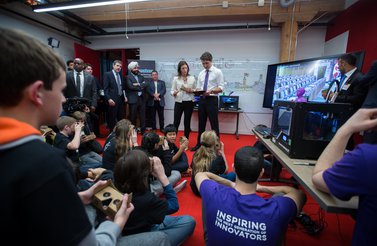Canada’s federal government recently released an innovation scorecard, Building a Nation of Innovators, which takes stock of the government’s efforts over the past three years. The report emphasizes its significant spending record, including $950 million for the superclusters, $4 billion for science research, $795 million in 31 strategic innovation fund agreements and $2.3 billion for clean technology support. While the benefits from this spending will take years to realize, increased investments in strategic sectors are the easy part of innovation policy. Enacting new rules and regulations that support an innovative economy is more challenging. On that front, the government’s record is more modest. The limited intellectual property (IP) reforms made to date are aimed at resolving the frustrating administrative processes at the Copyright Board of Canada and are designed to guard against IP misuse. Many other critical innovation policy issues — data governance, copyright reform, privacy modernization, telecommunications regulation — remain works-in-progress, with major legislative changes still years away from enactment.
There is a link between innovation policy and copyright reform; four reforms, in particular, are both long overdue and closely linked to the government’s supercluster approach. These include a text and data mining exception — sometimes referred to as an information analysis exception — to support artificial intelligence (AI), flexible fair dealing in support of digital technologies and advanced manufacturing, open government data and the elimination of Crown copyright in connection with the ocean supercluster, and the easing of digital lock restrictions that place Canadian agriculture and the protein innovation supercluster at a competitive disadvantage.
Increased investments in strategic sectors are the easy part of innovation policy. Enacting new rules and regulations that support an innovative economy is more challenging.
The failure to integrate legislative reform as a central focus of the government’s innovation strategy leaves the sense that Canada is trying to spend its way toward a more innovative economy, rather than prioritizing policy development that might establish the legal tools needed to better enable private sector innovation to thrive. This approach is disappointing, given both the obvious opportunities for reforms to facilitate innovation and the need for policies to help leverage the multi-billion-dollar investment of public tax dollars.
AI and an Informational Analysis Exception
The federal government has placed a big bet on Canada becoming a world leader in AI, investing millions of dollars on a national strategy to support research and commercialization. The hope is that by attracting high-profile talent and significant corporate support, the government can turn a strong AI research record into an economic powerhouse. Given the emphasis on AI, it should be no surprise that the government chose to develop an AI supercluster. The SCALE AI supercluster, in Montreal, is focused on developing intelligent supply chains and improving industrial performance, bringing together companies and experts from a wide range of communities.
Yet, despite the significant investment in AI, Canada still faces policy barriers to future success, including restrictive copyright rules that may hamper the ability of companies and researchers to test and ultimately bring new AI services to market. Making machines smart — whether they’re engaging in automated translation, big data analytics or new search capabilities — is dependent on the data being fed into the system. Machines learn by scanning, reading, listening or viewing human-created works. The better the inputs, the better the output and the reduced likelihood that results may be biased or inaccurate.
Copyright law is relevant because restrictive rules may limit the data sets that can be used for machine-learning purposes, resulting in fewer pictures to scan, videos to watch, or text to analyze. Given the absence of a clear rule to permit machine learning in Canadian copyright law (often called a text and data mining exception), the existing legal framework trails behind those of other countries that have reduced the risks associated with using data sets in AI activities.
For example, consider how machines are taught to translate languages. Several years ago, the United Nations released nearly a million manually translated documents in the six official UN languages (English, French, Spanish, Arabic, Russian and Chinese) for machine use. By releasing documents containing perfect translations in multiple languages, the data set helped create better automated translation systems. Indeed, official government documents have been an important data source for automated translation, because they offer professionally translated materials of identical content.
There is, of course, a downside: treaties and diplomatic correspondence rarely mimic everyday speech. Better systems would benefit from a broader range of materials, such as translated popular books or television shows. The goal is not to republish or compete with copyright materials, but rather to ensure that researchers and AI companies can mine the text and data for informational analysis purposes.
Canadian courts have ruled that fair dealing — the copyright law’s foundational exception that permits use of materials without the need for prior permission — is a user’s right that should be interpreted in a broad and liberal manner. There are several purposes that would permit some text and data mining activities: research, education and private study. However, given Canada’s emphasis on the commercial benefits of AI, the law may not offer sufficient flexibility to safely move from the lab, classroom or supercluster to the market.
Other countries have tried to address the issue by creating a specific exception for text and data mining or computer informational analysis. For example, Britain’s exception allows copies of works to be made without permission of the copyright owner for the purposes of automated analytical techniques to analyze text and data for patterns, trends and other information. The law does not allow contracts to restrict data mining activities, but the exception is limited to non-commercial research.
Text and data mining exceptions are becoming increasingly popular. For example, Japanese law features an exception, and the European Union has been debating adding one as well. Again, Canada risks falling behind in the race to commercialize AI research because of an overly restrictive copyright law. The copyright review committee heard repeatedly that there is a need for an “informational analysis” exception that would reduce the risks associated with using data sets in AI activities. Those recommendations came from some of the world’s leading AI companies, pointing to both the mounting interest in Canada’s AI sector and the concern that legal rules need to be updated in order to maximize its innovative potential.
Digital Technology, Advanced Manufacturing and Flexible Fair Dealing
Two other superclusters — digital technology (based in British Columbia) and advanced manufacturing (based in Ontario) — are premised on commercializing innovation through new products, services and manufacturing techniques. The superclusters point to activities such as machine learning for a data commons, leveraging augmented reality and developing precision health services. In order to compete with other innovative economies, Canada would benefit from a more flexible approach to the use of copyrighted materials that may be used as materials for future innovation.
For example, led by the United States, some of the world’s most innovative countries, including Israel, South Korea and Singapore, have established fair use provisions within their copyright laws. Fair use, however, does not mean free use — rather, it means that there is a balance that allows certain uses of works without permission so long as the use is fair. Fair use economies facilitate “permissionless innovation,” where new businesses enjoy the freedom to innovate without fear of lawsuits or legal barriers from incumbent businesses who fear new competition.
Canada could emulate the US fair use model by making the current list of fair dealing purposes illustrative rather than exhaustive. In other words, rather than limiting the Canadian fair dealing provision to the eight purposes identified in the Copyright Act (research, private study, news reporting, criticism, review, education, parody and satire), the current list would be treated as fair dealing examples, with a court free to add to the list. This would more closely align the Canadian approach to the US model, where the exception is open to any purpose, as striking a fair balance depends upon the use of the work, not the purpose of the copying. Since machine learning does not harm the primary purposes of the original work, most text and data mining will qualify as fair use.
Short of adopting an unequivocal fair use provision — an approach that would also help address the AI concerns identified earlier — the ideal remedy is to make the current list of fair dealing categories illustrative rather than exhaustive. This can be best achieved by adding the words “such as” to the current provision. This would be a clean, technology-neutral approach, giving Canada the equivalent of a pro-innovative fair use provision but one based on the long-standing fair dealing jurisprudence. The approach would address concerns about legal uncertainty, maintain the Canadian fairness framework and ensure that Canadian copyright law does not impede future innovation.
The Ocean Supercluster and the Use of Government Data
The ocean supercluster, based in Halifax, promises innovation in the ocean economy, noting that Canada has the world’s longest coastline and fourth-largest ocean territory. As examples, it points to the potential for underwater sensors and communications systems, as well as for autonomous technologies, to improve inspection and maintenance of large marine assets. While these initiatives represent exciting opportunities, their success seems closely linked to the development of better public data that maps Canada’s ocean territory. Mapping data — alongside other public information and related research — raises the potential for notable copyright reforms that could help foster Canada’s innovation economy.
For example, emphasis on improving access to government data misses a broader question: should the public, including innovative companies, have the legal right to use government data in whatever manner it sees fit? Canada still retains “Crown copyright,” which reflects a centuries-old perspective that the government ought to control the public’s ability to use official documents. Today, Crown copyright extends for 50 years from creation, and it requires anyone who wants to use or republish a government report, parliamentary hearing or other work to first seek permission.The existence of Crown copyright affects both print and audiovisual worlds and is increasingly viewed as a barrier to innovation, including in Canadian filmmaking, political advocacy and educational publishing. The government has established an open licence to address some Crown copyright concerns, but a more innovative system, consistent with Canada’s innovation ambitions, would be to establish a presumption that government materials belong to the public domain and are to be freely used without prior permission or compensation.
The government could also strengthen its copyright approach to publicly funded research publications. In recent years, many countries, including Canada, have taken strong steps toward making their research openly available. This approach uses legislative mandates that require researchers who accept public grants to make their published research freely available online within a reasonable time period. The basic principle behind open access is to facilitate public access to research, in particular research funded by taxpayers. Public access can be achieved by publishing the research in an open access journal or simply by posting it online.
While the policies have increased access to publicly funded research, some publishers have tried to limit the ability of researchers to make their works available under open access licences. According to a presentation Mark Leon De Vries delivered during the 2018 Septentrio conference series, the Netherlands has passed copyright legislation that could provide a model to restore the balance. Known as the Taverne amendment, the law states that academic articles resulting from research that is wholly or partly publicly funded may be placed in open access by the author after a reasonable period of time. Since the provision cannot be waived or overridden by contract, it removes the need for researchers to negotiate public access with publishers.
Protein Innovation and Canada’s Restrictive Digital Lock Rules
Copyright law seems like an unlikely issue for the competitiveness of Canadian agriculture and national ambitions for innovation through the protein supercluster based in Saskatchewan. Yet Canadian copyright law’s anti-circumvention provisions, often referred to as digital lock rules, provide legal protection for the technologies that lock down or limit use of digital content. The Canadian digital lock rules were enacted in 2012 under pressure from the United States, which wanted Canada to mirror its safeguards on ebooks, DVDs, digital devices and other digital applications. The Canadian regulations are among the most restrictive in the world, extending far beyond the World Intellectual Property Organization’s treaty requirements.
While this issue would seemingly have little connection to agriculture and protein innovation, the reality is that increasingly sophisticated farm equipment contains many of the same features as video game consoles or other software-enabled devices. In the case of farm equipment, the copyright rules have been leveraged by manufacturers to limit farmers' “right of repair.” These limitations may prohibit Canadian farmers from tinkering with their equipment to create new innovations or simply to repair malfunctioning equipment. As Carlo Dade of the Canada West Foundation noted in a December 2018 op-ed, “Currently, in the middle of critical harvest time, a farmer in Emerson, Man., can look across the border to Pembina, N.D., and see a farmer there hack her tractor to fix a problem without consequence. But should the Manitoba farmer try this she would face serious sanction. Or more starkly, the Manitoba farmer could drive their tractor across the border to hack the software without problem or sanction, but should she drive the tractor back into Canada she would be driving into trouble.”
The courts have interpreted the Canadian rules in a very restrictive manner. For example, in March 2017, the Federal Court of Canada ruled on a case involving the sale and distribution of “modchips,” which can be used to circumvent digital controls on video game consoles. Nintendo filed a lawsuit against a modchip retailer in 2016, arguing that the distribution of modchips violated the law, even without any evidence of actual copying.
With a copyright review underway, the government has an exceptional opportunity to advance a policy agenda by levelling the innovation law playing field.
The federal court agreed and awarded $12.7 million in damages after pointing to the 2012 anti-circumvention rules that largely mirror US legal restrictions on bypassing copy and access controls. The court adopted an aggressive approach in interpreting the digital lock provisions, while also taking a narrow view of exceptions that were originally designed to safeguard against legitimate issues, such as the interoperability of computer programs. If followed by other courts, the ruling could similarly restrict the applicability of exceptions related to privacy, security research and access for the blind.
The application of copyright law to farming equipment may seem surprising, yet there has long been concern about broad digital lock rules that create legal safeguards against digging into the software code potentially applying to devices as wide-ranging as garage door openers and printer ink cartridges.
Last year, after farmers protested against the copyright restrictions, the United States established specific exceptions permitting digital locks to be circumvented to allow repair of software-enabled devices. The new US exception is part of a gradual loosening of the digital lock rules in that country including new exceptions for automotive security research, repairs and maintenance, archiving and preserving video games, and remixing videos from DVDs and Blu-Ray sources.
Canada has the power to introduce new digital lock exceptions within the law but has yet to do so. In fact, during the final stages of the copyright reform process in 2012, the Liberals supported an amendment to expand the digital lock exceptions to cover circumventions for all lawful purposes. As Liberal Member of Parliament Geoff Regan noted when speaking in support of the change, “what the government seems to want to do is preserve old models and ignore the fact that we have moved into a digital world.” Regan cited comments from software developers, librarians and archivists, who all warned of the dangers of overly restrictive digital lock rules.
Conclusion
The Canadian government’s commitment to an innovation-led economic strategy has rightly garnered support from across the business and academic communities. Indeed, the supercluster strategy has succeeded in galvanizing increased collaboration and signaled Canada’s innovation priorities. Yet, beyond investing in innovation, the government should be pursuing a policy-driven regulatory framework that removes potential legislative barriers. Copyright may seem like an unlikely place to start, but with a copyright review underway, the government has an exceptional opportunity to advance a policy agenda by levelling the innovation law playing field.





